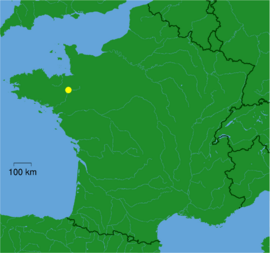Rennes
|
||||||||||||||||||||||||||||||||||||||||||||

Some medieval houses, such as these at Champ-Jacquet, can still be found in the center of Rennes.
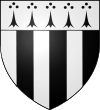
Blazon of Rennes
|
||||||||||||||||||||||||||||||||||||||||||||
Rennes (Gallo: Resnn, Breton: Roazhon, Latin: Condate, Condate Riedonum) is a city in the east of Brittany in northwestern France. Rennes is the capital of the Bretagne region, as well as the Ille-et-Vilaine department.
Contents[hide] |
Demographics
Population of the city (commune) of Rennes at the 1999 census was 206,229 inhabitants (209,100 inhabitants as of February 2004 estimates). Population of the metropolitan area at the 1999 census was 521,188 inhabitants, and 588,684 inhabitants as of 2007 estimate. Inhabitants of Rennes are called Rennais.
| 1793 | 1800 | 1806 | 1821 | 1831 | 1836 | 1841 | 1846 | 1851 |
|---|---|---|---|---|---|---|---|---|
| 30,160 | 25,904 | 29,225 | 29,589 | 27,340 | 35,552 | 37,895 | 39,218 | 39,505 |
| 1856 | 1861 | 1866 | 1872 | 1876 | 1881 | 1886 | 1891 | 1896 |
| 45,664 | 45,483 | 48,283 | 52,044 | 57,177 | 60,974 | 66,139 | 69,232 | 69,937 |
| 1901 | 1906 | 1911 | 1921 | 1926 | 1931 | 1936 | 1946 | 1954 |
| 74,676 | 75,640 | 79,372 | 82,241 | 83,418 | 88,659 | 98,538 | 113,781 | 124,122 |
| 1962 | 1968 | 1975 | 1982 | 1990 | 1999 | 2005 | - | - |
| 151,948 | 180,943 | 198,305 | 194,656 | 197,536 | 206,229 | 210,500 | - | - |
| Starting in 1962: Population with duplicates - Sources : Cassini[1] et INSEE[2] | ||||||||
Administration
The current mayor of Rennes is Daniel Delaveau, a member of the Socialist Party who replaced retiring Socialist incumbent Edmond Hervé, in office since 1977 in 2008. The mairie (mayor's office) is right in the centre of Rennes.
Rennes is divided into 11 cantons:
- Canton of Rennes-Brequigny (15,397 inhabitants)
- Canton of Rennes-Centre (19,017 inhabitants)
- Canton of Rennes-Centre-Ouest (21,264 inhabitants)
- Canton of Rennes-Centre-Sud (15,774 inhabitants)
- Canton of Rennes-Est (20,323 inhabitants)
- Canton of Rennes-le-Blosne (21,151 inhabitants)
- Canton of Rennes-Nord (21,845 inhabitants)
- Canton of Rennes-Nord-Est (18,224 inhabitants)
- Canton of Rennes-Nord-Ouest, which includes parts of Rennes but also the communes of Gévezé, Pacé and Parthenay-de-Bretagne (28,130 inhabitants)
- Canton of Rennes-Sud-Est, which includes parts of Rennes and the communes of Chantepie and Vern-sur-Seiche (33,459 inhabitants)
- Canton of Rennes-Sud-Ouest, which includes parts of Rennes and the communes of Saint-Jacques-de-la-Lande and Vezin-le-Coquet (28,707 inhabitants)
Since the 2008 cantonal elections, all eleven cantons are held by Socialists or their allies. The right held Rennes-Nord-Ouest until 2008.
Geography
The ancient centre of the town is built on a hill, with the north side being more elevated than the south side. It is at the confluence of two rivers: the Ille and the Vilaine.
Sights
Rennes is classified as a city of art and history.
Historic Centre
The Parlement de Bretagne (Parliament of Brittany, Plasenn Breujoù Breizh) is arguably the most famous 17th century building in Rennes. It was rebuilt after a terrible fire in 1994. It houses the Rennes Court of Appeals.
Basilica Saint-Sauveur is also located in the historic centre.
Colourful traditional timber frame houses are situated primarily along the roads of Saint-Sauveur, Saint-Georges, de Saint-Malo, Saint-Guillaume, des Dames, du Chapitre, Vasselot, Saint-Michel, de la Psallette and around the plazas of Champ-Jacquet, des Lices, Saint-Anne and Rallier-du-Baty.
There are 16th century polychromatic wooden busts in the façade of 20, Rue du Chapitre.
- Place des Lices and surrounding area
- Les Halles Martenot of the 19th century, built between 1868 and 1871 by Jean-Baptiste Martenot, host the market on Saturday mornings (the third largest market in France).
- The Mordelaises Gate (Portes Mordelaises), chatelet with two towers and a drawbridge
- The remaining fortifications of the 3rd century
- The Jehan Duchesne tower of the 15th century, on rue Nantaise
- The 15th century ramparts east of the Gallo-Roman fortifications, in place Rallier-du-Baty.
- The former St. Yves chapel, now the tourist bureau and a museum about historic Rennes development.
- Place Saint-Anne (Plasenn Santez-Anna)
- Saint-Aubin Church
- Location of a former 14th century hospital
- Jacobite convent
- La rue Saint-Michel nicknamed rue de la soif (road of thirst) because there are bars all along this street.
- Area from Saint-Mélaine to Place Saint-Mélaine
- Notre-Dame en Saint-Mélaine Church,
- Magnificent park, The Parc Thabor, (formal French garden, orangerie, rose garden, aviary), on 10 hectares of land, built between 1860 and 1867.
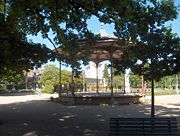
-
- The 17th century promenade "la Motte à Madame", and a monumental stair overlooking the rue de Paris entrance to the Thabor.
- Rue Saint-Georges and rue Gambetta
- 1920s Saint George Municipal Pool, with mosaics
- Saint George Palace, and its garden
- Place de la Mairie (City Hall Plaza, Plasenn Ti Ker)
- City Hall
- Opera
- Place du Vau-Saint-Germain
- Vau de Saint-Germain Church
- Saint-Germain footbridge, 20th century wood and metal construction to link the plaza with Émile Zola Quay.
- Place du Champ-Jacquet
- statue of Leperdit ripping up a conscription list.
South of the Vilaine
The Fine Arts Museum is situated on Quai Émile Zola (Émile Zola Quay), by the Vilaine River.
Les Champs Libres is a building on Esplanade Charles de Gaulle designed by the architect Christian de Portzamparc that houses the Brittany Museum (Musée de Bretagne), regional library Bibliothèque de Rennes Métropole on six levels and a Espace des Sciences science centre with a planetarium. At Place Honoré Commeurec is Les Halles centrales, a covered market of 1922, with a part converted into contemporary art gallery.
Mercure Hotel is located in a restored building on rue du Pré-Botté, which was the prior location of Ouest-Éclair, and then of Ouest-France, a premier daily regional newspaper.
There are large mills at Rue Duhamel, constructed on each side of the south branch of the Vilaine in 1895 and 1902.
Other sights
To the North-west of Rennes, near rue de Saint-Malo are the sluices of the canal d'Ille-et-Rance of 1843. There are two halls of the printer, Oberthür, built by Marthenot between 1870 and 1895 on Rue de Paris in the eastern part of the city. Oberthür Park is the second biggest garden in the city. The 17th century manor of Haute-Chalais, a granite chateau, is situated to the south of the city in Blosne Quarter (Bréquigny).
History
Rennes is the capital of the région of Brittany, in France, the seat of the 'préfecture de région' and of the 'conseil régional'. It has a long history due to its location at the confluence of two rivers.
The eastern Armorican people of Redones founded Condate— an ancient Celtic word meaning confluent— at the confluence of the Ille and Vilaine rivers and made it the capital of a territory that extended to the Bay of Mont Saint-Michel. The name of the city of Redon also reflects that of the Redones. Early in the 1st century BCE, they adopted the Greek and Roman practice of issuing coinage[3], adapting the widely-imitated gold staters of Philip II of Macedon, in the characteristic Celtic coin metal alloy called billion. Without inscriptions, as the Celtic practice was, the Redones coinage features a charioteer whose pony has a human head. Large hoards of their coins were unearthed in the "treasure of Amanlis" found in June 1835 and that of Saint-Jacques-de-la-Lande, discovered in February 1941. The Museum at Rennes contains a large representative collection.
They joined the Gaulish coalition against Rome in 57 BC, which was suppressed by Crassus. The following year, Roman emissaries were held hostage by the Redones, which obliged Julius Caesar to intervene in Armorica and suppress the rebels, and the following year to cross the Channel to discourage further support of the Redones by the Britons. In 52 the Redones responded to the call of Vercingetorix to furnish a large contingent of warriors[4]
Roman era
In the Roman era, Condate became Condate Riedonum, capital of Civitas Riedonum.
The oldest known rennais is Titus Flavius Postuminus, known to us from his steles found in Rennes in 1968. As indicated by his name, he would have been born under the Flavian dynasty, under the reign of Titus, i.e. between 79 and 81 AD. One of the steles tell us, in Latin, that he took charge over all the public affairs in the Civitas Riedonum. He was twice duumvir and flamine for life for Mars Mullo.
During the Roman era, the strategic position of the town contributed to its importance. To the west the principal Roman route, via Osismii stretched from Condate to Vorgium (modern Carhaix).
In the year 275, the threat of barbarians led to the erection of a robust brick wall around Rennes. Rennes became known as the "red town".
Threatened by the danger of peasant marauders called bagaudae at the end of the Roman Empire in the fifth century, the Armorican peninsula, including Brittany and therefore Rennes, made up the last of the stronghold of the western Roman Empire. The invincible Armorican Romans held their ground against Clovis I, who occupied most of Alamans, then the Visigoths. Melaine, the bishop of Rennes, played an important role in the peace treaty between the Franks and the Armoricans in the year 497. He famously declared "Il faut faire la paix entre chrétiens" ("Peace must be made between Christians").
Middle Ages
Starting in the fifth century, Bretons occupied the western part of the Armorican peninsula, which started to be called little Britain, and then Brittany, while the Franks took the rest of Armorica. To contain the expansion and avoid Breton incursions, the Carolingians instituted a Breton march, composed of the counties of Rennes, Nantes, and Vannes.
These marches were entirely absorbed by the Breton Kingdom in the ninth century, and Rennes became Breton in 851. Rennes would later become the capital of Ducal Brittany.
During the Breton War of Succession, in 1356 and 1357, the city was laid siege to by Henry of Grosmont, the Duke of Lancaster, cousin of the English king, but Bertrand du Guesclin slipped into the city and took over the resistance, which would ultimately be victorious. After nearly a year, Lancaster renounced the English siege in 1357.
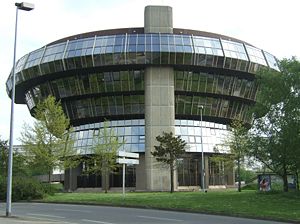
In 1491, it was the French army of Charles VIII, led by his general, La Trémoïlle, that unsuccessfully attacked Rennes. Brittany having already capitulated elsewhere, Rennes alone still resisted. The defenders of Rennes were determined to resist to the death, but the Duchess Anne of Brittany chose instead to negotiate. By her marriage to Charles VIII, she made Brittany a part of France. Anne jealously guarded Brittany's autonomy, but the duchy was eventually fully merged with the French crown by her daughter Claude of France.
Modern era
In 1857 the Rennes train station was built, which gradually led to the southward sprawl of the town. In 1899 Alfred Dreyfus' trial in Rennes caused a national commotion.
During World War II Rennes suffered heavy damage from just three German airplanes which hit an ammunition train parked alongside French and English troop trains and near a refugee train on the yard: 1,000 died. The next day, June 18 1940, German troops entered the city. Later, Rennes endured heavy bombings in March and May 1943, and again in June 1944, causing thousands of deaths. Patton's army freed the capital of Brittany on August 4, as retreating German troops blew the bridges behind them, adding further damage. About 50,000 German prisoners were kept in four camps, in a city of only about 100,000 inhabitants at the time.
From 1954 onwards the city developed extensive building plans to accommodate upwards of 520,000 inhabitants, helping it become the third fastest-growing city in France, after Toulouse and Montpellier (1999 census).
Economy
Local industries include car manufacturing and telecommunications. PSA Peugeot Citroën, currently the largest employer of the population of Rennes, opened a manufacturing plant at Rennes La Janais in 1961. Thomson employs over 1,000.
Rennes is also one of first Technopoles in France that were established in an effort to stimulate the economies of regions other than Paris during the Aménagement du territoire.
Culture
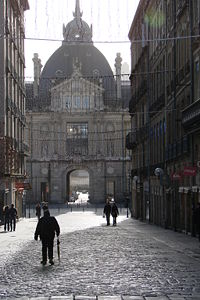
Rennes invests heavily in arts and culture and a number of its festivals (such as the music festival Les Transmusicales, les Tombées de la Nuit and Travelling (a cinematic festival)) are well known throughout France. Rennes was one of the first towns in France to have its own television channel 'TV Rennes', created in 1987. In Rennes is the only Institut Franco-Américain in France. There are 4 museums in Rennes:
Musée des Beaux Arts (Art Gallery).
Musée de Bretagne (Museum of Brittany) at the Champs Libres, together with le 'espace of sciences' and a planetarium.
Museum of Farming and Rennes Countryside at la Bintinais, south of Rennes.
Musée des Transmissions (Museum of Broadcasting) at Cesson-Sévigné, west of Rennes center.
Education
The Rennes agglomeration has a large student population (around 60,000). The Breton language is taught in one Diwan school, some bilingual public and catholic schools, in evening courses, and in university.[5]
The city has two main universities; Université de Rennes 1 (site), which offers courses in science, technology, medicine, philosophy, law, management and economics and Université Rennes 2 (site), which has courses in the arts, literature, languages, communication, human and social sciences, sport.

There are a few École Supérieures in Rennes. The École Normale Supérieure de Cachan has a branch on the Ker Lann campus, just outside Rennes. An École Supérieure for political science, Institut d'études politiques de Rennes (site), is also based in Rennes.
There is also a branch of École Supérieure d'Électricité - Supélec in the east of the city (Cesson-Sévigné), Ecole Supérieure de Commerce de Rennes and the grande école Institut National des Sciences Appliquées, which is next to the "École Nationale Supérieure de Chimie de Rennes".
The computer science and applied mathematics research institute, IRISA, is located on the campus of the Université des Sciences, nearby Cesson-Sévigné. The Délégation Générale pour l'Armement (defense procurement agency) operates the CELAR research center, dedicated to electronics and computing, in Bruz, a neighboring town.
Football club
Rennes is home to Stade Rennais FC, who play at Route de Lorient stadium, 31,000 seats in the French Division One.
Transportation
Rennes has well developed national road, rail and air links and is two hours by TGV from Paris. Local transport is based primarily on an extensive bus network (38 different lines) and a metro line that was inaugurated in March 2002 and cost €500 millions to build. The driverless Rennes Metro is 9.4 km in length and has 15 stations, including one designed by architect Norman Foster.
A second metro line is being planned, it should be operational by 2018, and the construction will begin in 2013.[6]
See also: Gare de Rennes
Rennes is also served by an airport, Rennes-St. Jacques Airport, located 4.5 miles (7.2 km) from the center to the south-west in the commune Saint-Jacques-de-la-Lande.
Sister cities
These twinned towns are inscribed on the bridge over the central canal of Rennes:
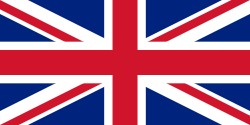 Exeter (UK) since 1957.
Exeter (UK) since 1957.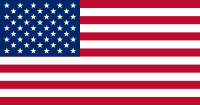 Rochester (New York, USA) since 1958.
Rochester (New York, USA) since 1958. Erlangen (Germany) since 1964.
Erlangen (Germany) since 1964.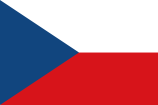 Brno (Czech Republic) since 1965.
Brno (Czech Republic) since 1965. Sendai (Miyagi, Japan) since 1967.
Sendai (Miyagi, Japan) since 1967. Leuven (Belgium) since 1980.
Leuven (Belgium) since 1980. Cork (Ireland) since 1982.
Cork (Ireland) since 1982. Setif (Algeria) since 1982.
Setif (Algeria) since 1982. Rennes-les-Bains (Aude, France) since 1985.
Rennes-les-Bains (Aude, France) since 1985. Jinan (Shandong, China) since 1985.
Jinan (Shandong, China) since 1985. Almaty (Kazakhstan) since 1991.
Almaty (Kazakhstan) since 1991. Poznań (Poland) since 1998.
Poznań (Poland) since 1998.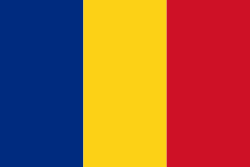 Sibiu (Romania) since 1999.
Sibiu (Romania) since 1999. Plateau Dogon (Mali) since 1999.
Plateau Dogon (Mali) since 1999.
Broadcasting facilities
- Transmitter Rennes-Thourie
References
- ↑ Population avant le recensement de 1962
- ↑ INSEE : Population depuis le recensement de 1962
- ↑ http://www.cgb.fr/monnaies/vso/v15/gb/sommairegb63d2.html?sommaire=Armorica%2C%20Redones%20coinage%20(Rennes)&nbfic=1515
- ↑ Caesar, Gallic Wars II.34; VII.75
- ↑ (French) L'état de la langue bretonne dans l'enseignement en Ille-et-Villaine (State of the Breton language in education in Ille-et-Villaine) from Ofis ar Brezhoneg
- ↑ (French) Rennes.maville.com Le projet de nouvelle ligne du métro sur les rails
External links
- Rennes Airport
- City council website
- Parlement de Bretagne
- Rennes travel guide from Wikitravel
- Photos of Rennes
- Rennes improvisation theatre
- [http://maps.google.com/maps?f=q&hl=en&q=rennes+france&ll=48.113964,-1.671295&spn=0.067161,0.193634&t=k&om=1 Rennes in Google
- Colors of Rennes - photoblog
Maps]
|
||
|
||
|
||

